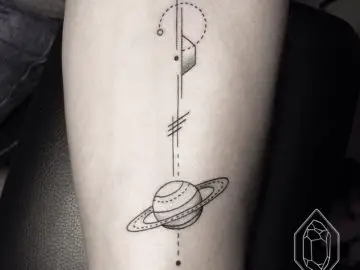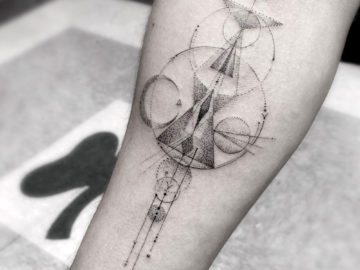These geometric tattoos are so unique and captivating! We can’t get enough!
Geometry (from the Ancient Greek: γεωμετρία; geo- “earth”, -metron “measurement”) is a branch of mathematics concerned with questions of shape, size, relative position of figures, and the properties of space. A mathematician who works in the field of geometry is called a geometer. Geometry arose independently in a number of early cultures as a body of practical knowledge concerning lengths, areas, and volumes, with elements of formal mathematical science emerging in the West as early as Thales (6th century BC).
By the 3rd century BC, geometry was put into an axiomatic form by Euclid, whose treatment—Euclidean geometry—set a standard for many centuries to follow. Archimedes developed ingenious techniques for calculating areas and volumes, in many ways anticipating modern integral calculus.
The field of astronomy, especially as it relates to mapping the positions of stars and planets on the celestial sphere and describing the relationship between movements of celestial bodies, served as an important source of geometric problems during the next one and a half millennia. In the classical world, both geometry and astronomy were considered to be part of the Quadrivium, a subset of the seven liberal arts considered essential for a free citizen to master.
The introduction of coordinates by René Descartes and the concurrent developments of algebra marked a new stage for geometry, since geometric figures such as plane curves could now be represented analytically in the form of functions and equations. This played a key role in the emergence of infinitesimal calculus in the 17th century.
Furthermore, the theory of perspective showed that there is more to geometry than just the metric properties of figures: perspective is the origin of projective geometry. The subject of geometry was further enriched by the study of the intrinsic structure of geometric objects that originated with Euler and Gauss and led to the creation of topology and differential geometry.
In Euclid\’s time, there was no clear distinction between physical and geometrical space. Since the 19th-century discovery of non-Euclidean geometry, the concept of space has undergone a radical transformation and raised the question of which geometrical space best fits physical space.
Contemporary geometry considers manifolds, spaces that are considerably more abstract than the familiar Euclidean space, which they only approximately resemble at small scales. These spaces may be endowed with additional structure which allow one to speak about length.
Modern geometry has many ties to physics as is exemplified by the links between pseudo-Riemannian geometry and general relativity. One of the youngest physical theories, string theory, is also very geometric in flavour.
While the visual nature of geometry makes it initially more accessible than other mathematical areas such as algebra or number theory, geometric language is also used in contexts far removed from its traditional, Euclidean provenance (for example, in fractal geometry and algebraic geometry).
Geometry originated as a practical science concerned with surveys, measurements, areas, and volumes. Among other highlights, notable accomplishments include formulas for lengths, areas and volumes, such as the Pythagorean theorem, circumference and area of a circle, area of a triangle, volume of a cylinder, sphere, and a pyramid. A method of computing certain inaccessible distances or heights based on similarity of geometric figures is attributed to Thales. The development of astronomy led to the emergence of trigonometry and spherical trigonometry, together with the attendant computational techniques.













































0 Comments